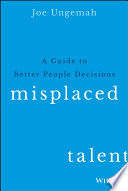

One of the central themes of 'Misplaced Talent' is the idea that organizations often misalign the skills of their employees with the roles they occupy. This misalignment leads to underutilization of talent and can stifle innovation and productivity. The book argues that organizations must take a more strategic approach to talent management, ensuring that individuals are placed in roles that leverage their unique skills and strengths. It emphasizes the importance of understanding employee capabilities and aligning them with organizational needs to maximize both employee satisfaction and overall performance.
Continue readingThe book delves into the tangible and intangible costs associated with poor talent management. It discusses how organizations can suffer from decreased morale, higher turnover rates, and reduced productivity when employees are not well-matched to their roles. The author provides case studies and data to illustrate the financial impact of these issues, highlighting that investing in proper talent management strategies can lead to significant long-term savings and improved organizational health.
Continue readingLeadership plays a crucial role in effective talent management. 'Misplaced Talent' emphasizes that leaders must be proactive in identifying and nurturing talent within their organizations. The book discusses various leadership styles and their impact on employee engagement and development. It advocates for leaders to adopt a more hands-on approach in understanding their team's skills and fostering an environment where employees feel valued and motivated to contribute to their fullest potential.
Continue readingThe author underscores the importance of data in making informed talent management decisions. 'Misplaced Talent' argues that organizations should leverage data analytics to assess employee performance, skills, and potential. By utilizing data, organizations can better identify talent gaps, optimize hiring processes, and create tailored development programs that address specific needs. This data-driven approach not only enhances talent management practices but also contributes to a more agile and responsive organizational culture.
Continue readingThe book highlights the necessity of fostering a culture of continuous learning within organizations. It posits that in a rapidly changing business environment, organizations must encourage employees to continually develop their skills and adapt to new challenges. 'Misplaced Talent' outlines strategies for creating learning opportunities, such as mentorship programs, training sessions, and collaborative projects, which can help employees grow and feel more engaged in their work.
Continue readingFeedback is a critical component of effective talent management. 'Misplaced Talent' discusses how organizations can create a feedback-rich environment where employees feel comfortable sharing their thoughts and experiences. The book provides practical tips for implementing regular feedback mechanisms, such as performance reviews and informal check-ins, which can help identify areas for improvement and ensure that employees feel heard and valued.
Continue readingFinally, the book emphasizes the importance of aligning organizational goals with the aspirations of employees. 'Misplaced Talent' argues that when employees see a clear connection between their personal goals and the objectives of the organization, they are more likely to be engaged and committed to their work. The author suggests strategies for fostering this alignment, such as involving employees in goal-setting processes and providing opportunities for career advancement that align with both individual and organizational objectives.
Continue reading